Kathmandu, the capital and largest city of Nepal, serves as the political, economic, and cultural hub of Nepal. With a population of over 1 million, in a small valley, it is home to a diverse array of ethnic groups and offers a unique blend of ancient and modern elements.
Over the centuries of Kathmandu’s existence, various dynasties have ruled the city, leaving their mark on its architecture, culture, and traditions. No wonder, the city boasts an impressive collection of temples, palaces, and ancient structures, many of which have been designated as UNESCO World Heritage Sites.
Serving as the gateway to the magnificent Himalayas, Kathmandu offers a plethora of activities ranging from sightseeing and cultural immersion to trekking and adventure sports. With its rich history, diverse culture, and stunning natural beauty, Kathmandu has become a popular destination for tourists from around the world seeking a unique and unforgettable experience.
Kathmandu is home to a multitude of ethnic groups, including the Newar, Gurung, Tamang, and Sherpa communities, among others. This diversity is well reflected in the city’s festivals, customs, music, dance, and cuisine which you can witness and participate in.
History of Kathmandu
Kathmandu’s history dates back to ancient times, and the city has been ruled by several dynasties over the centuries. This rich historical legacy is evident in the architectural masterpieces and ancient structures scattered throughout the city. The presence of UNESCO World Heritage Sites, such as the Pashupatinath Temple, Bouddhanath Stupa, Swayambhunath Stupa, and the Durbar Squares of Kathmandu, Patan, and Bhaktapur, highlights the city’s historical and cultural significance. To learn the history of Kathmandu is to learn all the lore, facts, origin, and everything in between.
Tourist Hub
Kathmandu is the gateway to your journey to the majestic Himalayas, blooming the adventure enthusiast and nature lover in you. The city offers various activities from trekking, mountaineering, white-water rafting, mountain biking, and paragliding. Furthermore, visitors can explore the bustling streets of Thamel, indulge in street foods and local cuisines, and shop for traditional handicrafts and souvenirs.
Purpose of the blog
The main purpose of this blog is to assist you plan your visit to Kathmandu, Nepal. With its varied culture, rich history, bustling streets, and a plethora of activities, Kathmandu can be both exciting and overwhelming for first-time visitors. Our aim is to make the planning process easier by answering common questions and addressing concerns that travelers may have.
By offering practical tips and insights, we hope to help visitors make the most of their time in Kathmandu and ensure a smooth, enjoyable, and memorable trip. We cover essential topics such as geography, climate, history, culture, attractions, local cuisine, accommodation, transportation, health and safety, and practical tips, offering a well-rounded understanding of what to expect and how to prepare for a visit to the city.
We also encourage you, the readers, to share your stories with us, of your experiences, suggestions, and recommendations via mail or other given communication methods. That way, this blog can become a valuable resource and a supportive community for travelers seeking advice and inspiration.
Geography and Climate
Surrounded by the Himalayas, Kathmandu sits at an altitude of approximately 1400 meters (4600 feet) above sea level. It is located in the Kathmandu Valley in the central part of the country. Kathmandu experiences a subtropical climate, characterized by mild temperatures and distinct wet and dry seasons. The monsoon season, which lasts from June to September, brings heavy rainfall and high humidity.
Kathmandu City covers an area of around 50.67 kilometers (19.56 square miles). The valley is surrounded by the Shivapuri, Nagarjun, Chandragiri, and Pulchowki mountain ranges, giving the city a picturesque backdrop.
Climate and Weather Patterns
 Kathmandu experiences a subtropical highland climate, characterized by mild temperatures and distinct wet and dry seasons. The city's weather patterns can generally be divided into four seasons:
Kathmandu experiences a subtropical highland climate, characterized by mild temperatures and distinct wet and dry seasons. The city's weather patterns can generally be divided into four seasons:
-
Spring (March to May): Spring is marked by mild temperatures, with average daytime temperatures ranging from 16°C to 23°C (61°F to 73°F). This season sees a gradual increase in precipitation, with occasional showers.
-
Summer/Monsoon (June to September): Summer in Kathmandu is dominated by the monsoon season, bringing heavy rainfall and high humidity. Daytime temperatures during this period range from 23°C to 27°C (73°F to 81°F). Flooding and landslides can occur during the monsoon, causing disruptions in travel.
-
Autumn (October to November): Autumn is characterized by cool, pleasant temperatures and clear skies, with daytime averages between 15°C and 22°C (59°F to 72°F). This season sees a significant decrease in rainfall, making it an ideal time for outdoor activities and sightseeing.
-
Winter (December to February): Winter in Kathmandu can be quite chilly, especially during the mornings and evenings. Daytime temperatures typically range from 9°C to 12°C (48°F to 54°F), while nighttime temperatures can drop to around 2°C (36°F). Occasional snowfall may occur in the surrounding hills.
Best times to visit Kathmandu
The best times to visit Kathmandu are during the spring (March to May) and autumn (October to November) seasons. These periods offer pleasant temperatures, clear skies, and relatively low rainfall, making them ideal for sightseeing, trekking, and other outdoor activities. Additionally, many festivals, such as Holi and Dashain, take place during these months, offering travelers the opportunity to experience Nepali culture at its finest.
While the monsoon season (June to September) brings heavy rainfall and potential travel disruptions, some travelers may still enjoy the lush green landscapes and fewer crowds during this time. Winter (December to February) is suitable for those who don't mind colder temperatures and are interested in exploring the city and its cultural attractions rather than trekking in the mountains.
History and Culture
As a melting pot of diverse ethnic groups and a crossroads of ancient trade routes, the city showcases a remarkable blend of architectural styles, religious beliefs, and artistic expressions. The vibrant mix of Hindu and Buddhist traditions, reflected in the city's numerous temples, shrines, and UNESCO World Heritage Sites, is a testament to its enduring cultural significance. Visitors to Kathmandu will find themselves immersed in the city's ancient heritage and unique customs, offering a captivating experience that bridges the past and present.
Brief History of Kathmandu
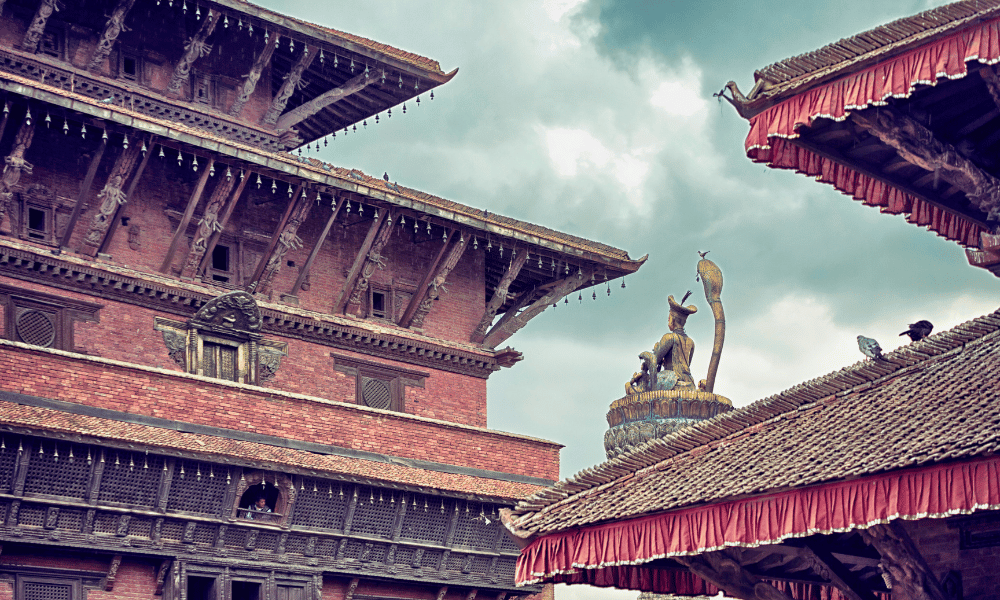 Kathmandu's history dates back to ancient times, with the city's origins believed to have been around the 12th century. Over the centuries, Kathmandu has been ruled by various dynasties, including the Licchavi, Malla, and Shah dynasties. Each of these ruling periods contributed to the city's architectural, cultural, and historical landscape.
Kathmandu's history dates back to ancient times, with the city's origins believed to have been around the 12th century. Over the centuries, Kathmandu has been ruled by various dynasties, including the Licchavi, Malla, and Shah dynasties. Each of these ruling periods contributed to the city's architectural, cultural, and historical landscape.
During the Licchavi period (c. 400-750 AD), Kathmandu saw the construction of numerous temples and monuments, many of which still stand today. The Malla period (1201-1769 AD) is considered the golden age of Kathmandu's cultural and artistic development, with the construction of the iconic Durbar Squares, palaces, and temples. The Shah dynasty (1768-2008) marked the unification of Nepal and the establishment of Kathmandu as the capital of the newly formed nation.
The Cultural Significance of the City
Kathmandu holds great cultural significance as a melting pot of diverse traditions, customs, and art forms. The city's rich cultural heritage is reflected in its architecture, festivals, music, dance, and cuisine. With numerous temples, palaces, and ancient structures, Kathmandu provides a fascinating glimpse into Nepal's history and culture.
Many of the city's cultural sites have been designated as UNESCO World Heritage Sites, further underscoring the city's importance in preserving and showcasing Nepal's unique cultural identity. Furthermore, Kathmandu is home to several important institutions, such as the Nepal Academy of Fine Arts, which promote the study and preservation of Nepali culture and arts.
Major Ethnic Groups and Languages
Kathmandu is home to a diverse range of ethnic groups, each with its own customs, traditions, and languages. The major ethnic groups found in the city include Newar, Brahmin, Chhetri, Tamang, and Gurung, among others. The Newar community, in particular, has played a significant role in shaping the city's cultural landscape.
Nepali is the official language and is spoken by the majority of the population. However, other languages, such as Newari, Maithili, Bhojpuri, and English, are also widely spoken and understood in the city.
Religious Beliefs and Practices
The predominant religions in Kathmandu are Hinduism and Buddhism, with a significant number of followers for both faiths. The city is home to several important religious sites, such as the Pashupatinath Temple (a Hindu pilgrimage site) and the Boudhanath and Swayambhunath stupas (important Buddhist sites). Religious practices and rituals play a crucial role in the daily lives of the city's residents, and many festivals and events revolve around religious celebrations.
 In addition to Hinduism and Buddhism, you will also find some smaller communities practicing Islam, Christianity, and other faiths in Kathmandu. This religious diversity contributes to the city's unique cultural fabric and fosters a sense of tolerance and understanding among its inhabitants.
In addition to Hinduism and Buddhism, you will also find some smaller communities practicing Islam, Christianity, and other faiths in Kathmandu. This religious diversity contributes to the city's unique cultural fabric and fosters a sense of tolerance and understanding among its inhabitants.
Sightseeing and Attractions
With numerous day trips available from Kathmandu, travelers can easily venture beyond the city to discover even more of Nepal's rich cultural and natural treasures as they explore the major attractions inside the city.
UNESCO World Heritage Sites
The city is home to several UNESCO World Heritage Sites, including the sacred Pashupatinath Temple, the stunning Boudhanath Stupa, the revered Swayambhunath Stupa, and the historic Durbar Squares of Kathmandu, Patan, and Bhaktapur.
Pashupatinath Temple:
Pashupatinath Temple, dedicated to the Hindu god Lord Shiva, is one of the most sacred Hindu pilgrimage sites in the world. Located on the banks of the Bagmati River, this temple complex showcases stunning architecture, with its main pagoda-style temple adorned with intricate wood carvings and a two-tiered golden roof. Non-Hindus are not allowed inside the main temple but can observe the rituals and ceremonies from designated areas. The temple also serves as a cremation site, where Hindu funeral rites are performed.
Boudhanath Stupa:
Boudhanath Stupa is one of the largest and most important Buddhist stupas in the world, attracting Buddhist pilgrims from around the globe. The stupa's massive white dome, topped with a gold spire adorned with colorful prayer flags, is an iconic symbol of Kathmandu. Visitors can walk around the stupa in a clockwise direction, which is a common Buddhist practice known as kora. The area surrounding the stupa is filled with monasteries, meditation centers, and shops selling religious artifacts, making it an ideal place to experience Tibetan Buddhist culture.
Swayambhunath Stupa:
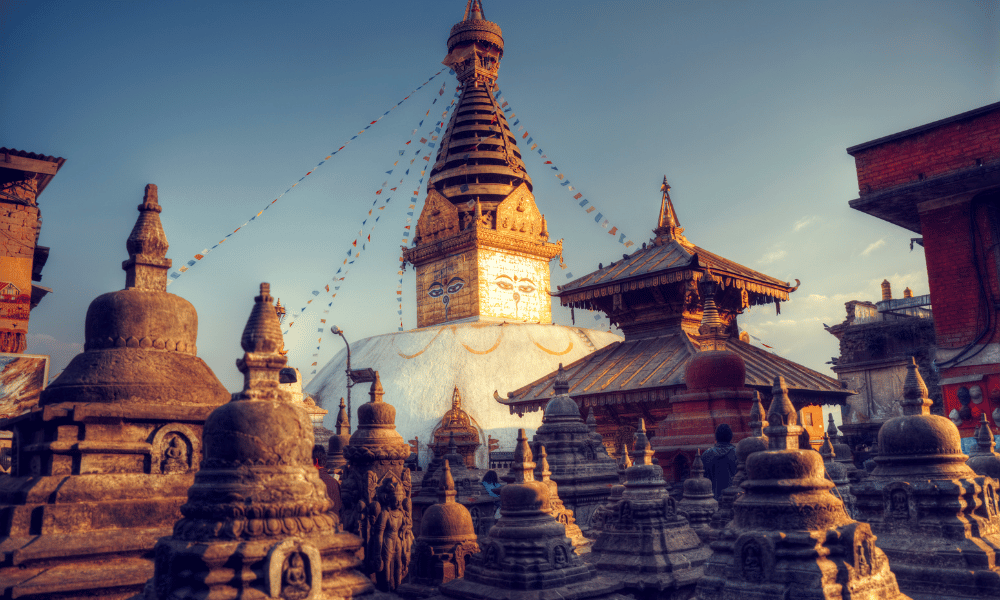 Also known as the Monkey Temple due to the large number of monkeys that reside there, Swayambhunath Stupa is another important Buddhist site in Kathmandu. Perched atop a hill, the stupa offers panoramic views of the city and is a popular spot for both tourists and locals. The stupa itself features a white dome, a gilded spire, and the watchful eyes of the Buddha painted on all four sides. Surrounding the stupa are numerous smaller shrines, temples, and a museum.
Also known as the Monkey Temple due to the large number of monkeys that reside there, Swayambhunath Stupa is another important Buddhist site in Kathmandu. Perched atop a hill, the stupa offers panoramic views of the city and is a popular spot for both tourists and locals. The stupa itself features a white dome, a gilded spire, and the watchful eyes of the Buddha painted on all four sides. Surrounding the stupa are numerous smaller shrines, temples, and a museum.
Durbar Squares (Kathmandu, Patan, and Bhaktapur)
The three Durbar Squares located in Kathmandu, Patan, and Bhaktapur are ancient royal palace complexes that showcase the architectural and artistic brilliance of Nepal's past. Each Durbar Square is unique and features a stunning array of temples, courtyards, monuments, and statues. Some key highlights of the squares include:
-
Kathmandu Durbar Square: Home to the Hanuman Dhoka Palace, Kumari Ghar (House of the Living Goddess), and various temples such as Kasthamandap and Taleju Temple.
-
Patan Durbar Square: Known for the Patan Royal Palace, Krishna Mandir, and the Patan Museum, which houses a remarkable collection of traditional Nepalese art.
-
Bhaktapur Durbar Square: Notable for the 55-Window Palace, Nyatapola Temple, and the Golden Gate, which serves as the entrance to the Royal Palace of Bhaktapur.
Visiting these UNESCO World Heritage Sites provides a fascinating insight into the rich cultural and historical heritage of Kathmandu and should be on every traveler's must-see list.
Other popular attractions
Beyond the iconic landmarks we mentioned before, visitors can explore the lively streets of Thamel, unwind at the serene Garden of Dreams, or delve into Nepalese history at the Narayanhiti Palace Museum.
Thamel
Thamel is a bustling commercial neighborhood in the heart of Kathmandu, popular among tourists and locals alike. Known for its narrow, winding streets lined with shops, restaurants, bars, and hotels, Thamel is a great place to experience the city's vibrant atmosphere. You can easily find a wide variety of souvenirs, handicrafts, clothing, and outdoor gear, as well as taste local and international cuisine at numerous eateries. Thamel also serves as the main starting point for many trekking and adventure tours.
Garden of Dreams
The Garden of Dreams is a beautifully landscaped garden located near Thamel. This serene oasis provides a peaceful escape from the bustling streets of Kathmandu, featuring well-manicured lawns, ponds, pavilions, and fountains. Visitors can relax on the garden benches, enjoy a picnic, or visit the Kaiser Café, which offers a range of refreshments and light meals.

Narayanhiti Palace Museum
The Narayanhiti Palace Museum, once the residence of Nepal's royal family, is now a museum open to the public. This grand palace showcases the history and lifestyle of Nepal's monarchy and offers visitors a glimpse into the country's past. The palace features a mix of traditional Nepali architecture and modern design elements, and its exhibits include royal artifacts, clothing, and photographs. You can also explore the palace grounds, which are home to beautiful gardens and fountains.
Recommended day trips from Kathmandu
These day trips from Kathmandu offer a diverse range of experiences and allow visitors to explore the natural beauty, wildlife, and cultural richness of Nepal beyond the capital city.
Nagarkot: Situated approximately 28 km from Kathmandu, Nagarkot is a popular hill station known for its stunning views of the Himalayas, including Mount Everest. Visitors can enjoy sunrise or sunset views, trekking, and nature walks in the surrounding areas.
Dhulikhel: Located about 30 km from Kathmandu, Dhulikhel is another hill station offering picturesque views of the Himalayas and a range of trekking options. The town is also home to several ancient temples and Newari-style architecture.
Chitwan National Park: A 4-5 hour drive from Kathmandu, Chitwan National Park is a UNESCO World Heritage Site and one of Nepal's most popular wildlife reserves. The park offers a range of activities, including jungle safaris, canoeing, and bird watching, and is home to diverse wildlife such as one-horned rhinoceros, Bengal tigers, and various species of birds.
Pokhara: Situated approximately 200 km from Kathmandu, Pokhara is a picturesque lakeside city that serves as a gateway to the Annapurna mountain range. You can take a 25 minutes flight from Kathmandu to Pokhara and enjoy boating on Phewa Lake, visit the World Peace Pagoda, or explore the numerous caves and waterfalls in the area. Pokhara is also a popular starting point for treks in the Annapurna region.
Local Cuisine
Kathmandu's local cuisine offers a delectable journey through Nepal's diverse culinary landscape. Traditional Nepali dishes, such as the quintessential dal bhat, momos, and sel roti, showcase a unique blend of flavors, spices, and cooking techniques influenced by the city's myriad ethnic groups.
You can also indulge in popular street food items, which provide an authentic Newari taste of daily life in Kathmandu. With a range of options to suit various dietary preferences and restrictions, the city's restaurants and cafes serve up both traditional and international fare, allowing travelers to savor the rich flavors of Nepalese cuisine while exploring the vibrant food scene in Kathmandu.
-
Traditional Nepali dishes
Dal Bhat: A staple Nepali meal consisting of steamed rice (bhat) served with lentil soup (dal) and accompanied by vegetable curries, pickles, and sometimes meat. Dal Bhat is typically eaten twice a day by most Nepalese.
Momo: These popular dumplings are filled with minced meat (chicken, buffalo, or pork) or vegetables, and can be steamed, fried, or served in a soup. Momos are often accompanied by spicy dipping sauces.
Sel Roti: A deep-fried, ring-shaped rice bread that is crispy on the outside and soft on the inside. Sel Roti is a popular snack and is often enjoyed during festivals and special occasions.
Gundruk: A traditional dish made from fermented and dried leafy green vegetables, usually served as a side dish or in soup. Gundruk is known for its tangy and slightly pungent taste.
-
Popular street food items
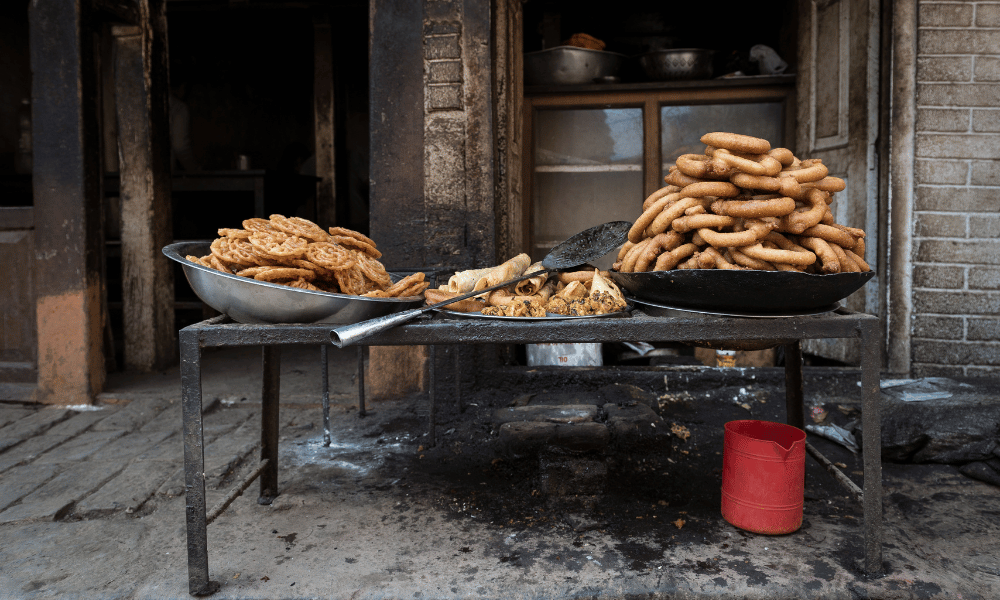 Chatamari: Often referred to as Nepali pizza, Chatamari is a thin, round rice-flour crepe topped with minced meat, vegetables, or egg, and seasoned with various spices.
Chatamari: Often referred to as Nepali pizza, Chatamari is a thin, round rice-flour crepe topped with minced meat, vegetables, or egg, and seasoned with various spices.
Pani Puri: A popular South Asian street food, Pani Puri consists of hollow, crispy puri shells filled with a mixture of potatoes, chickpeas, tamarind chutney, and spicy, tangy water.
Samosa: A deep-fried pastry filled with spiced potatoes, peas, or lentils, samosas are a popular snack in Nepal and can be found at various street food stalls.
Laphing: A spicy cold noodle dish of Tibetan origin, Laphing is made from mung bean or wheat flour and served with a flavorful sauce of soybean paste, garlic, and chili.
-
Dietary restrictions and considerations
Nepali cuisine is generally accommodating to various dietary restrictions. Vegetarian options are widely available, as many traditional dishes are plant-based or can be prepared without meat. For those with gluten sensitivities, rice, and rice-based dishes are common, though it is essential to communicate your needs to the restaurant or food vendor. Vegans may need to be cautious of dairy products, such as ghee or yogurt, used in some dishes.
-
Recommendations for restaurants and cafes
OR2K: A popular restaurant in Thamel offering a variety of vegetarian and vegan dishes, including Middle Eastern, Nepali, and international cuisine.
Yangling Tibetan Restaurant: Known for its authentic Tibetan dishes, Yangling offers delicious momos, thukpa, and other traditional favorites in a cozy setting.
Bhojan Griha: Housed in a beautifully restored traditional Newari building, Bhojan Griha offers an upscale dining experience and serves a range of Nepali and Newari dishes.
Thakali Bhanchha Ghar: This restaurant specializes in Thakali cuisine from the Mustang region and offers a delicious, traditional Dal Bhat experience with a variety of side dishes.
These are just a few recommendations, but Kathmandu has a vast culinary landscape to explore, with options ranging from local eateries to international restaurants and cafes. For more recommendations read :
Accommodation and Costs
Kathmandu offers a wide range of accommodation options to suit various preferences and budgets. Some of the types of accommodations available in the city include:

-
Budget hotels and guesthouses: These establishments offer basic amenities and are ideal for budget-conscious travelers or backpackers. Prices can range from $5 to $20 per night for basic rooms with shared or private bathrooms.
-
Mid-range hotels: These hotels typically provide a comfortable stay with additional amenities, such as air-conditioning, room service, and on-site restaurants. Rates for mid-range hotels typically range from $20 to $80 per night, with additional amenities included.
-
Luxury hotels and resorts: Catering to travelers seeking upscale accommodations, these establishments offer top-notch facilities, exceptional service, and additional amenities such as spas, swimming pools, and fine dining options. Prices for luxury accommodations can start from $80 and go up to several hundred dollars per night, depending on the level of luxury and facilities offered.
-
Bed and breakfasts: These family-run establishments provide a cozy, home-like atmosphere, with breakfast included in the room rate. Rates for B&Bs usually range from $15 to $60 per night, with breakfast included.
-
Hostels: Popular among backpackers and solo travelers, hostels offer dormitory-style accommodations and shared facilities at an affordable price. Hostel prices can vary from $3 to $15 per night for a dormitory bed, depending on the location and facilities offered.
-
Homestays: Homestays allow travelers to experience local culture and customs by staying with a Nepali family in their home. Homestay prices can range from $10 to $50 per night, depending on the location and the level of interaction with the host family.
Tips for Choosing the Right Place to Stay
When you are looking for a place to stay, you will need to keep track of what you need and what is convenient for you. Try these tips to make choosing your accommodation easier.
-
Consider your budget: Determine how much you are willing to spend on accommodations and choose a suitable option within your budget.
-
Location: Choose a place to stay that is conveniently located near attractions, transportation hubs, or the areas you plan to explore.
-
Amenities and facilities: Consider the amenities and facilities you require, such as Wi-Fi, air-conditioning, or private bathrooms, and make sure the accommodation you choose offers these services.
-
Reviews and recommendations: Read reviews from previous guests or ask for recommendations from friends or travel forums to get an idea of the quality and reputation of the accommodation.
Booking platforms and recommendations
When booking accommodations, it's always a good idea to compare prices across different platforms and read guest reviews to ensure you are getting the best deal and experience possible. There are various platforms available for booking accommodations in Kathmandu, such as:
-
Online booking websites: Websites like Booking.com, Expedia, and Agoda offer a wide range of accommodations with user reviews and ratings to help you make an informed decision.
-
Hotel and hostel websites: Some establishments have their own websites where you can book directly, often with the best rates and availability.
-
Travel agencies: Local or international travel agencies can help you book accommodations in Kathmandu, and may offer package deals that include transportation and activities.
Transportation
Transportation in Kathmandu encompasses a variety of options to suit the needs of travelers visiting the city. International flights and overland routes connect Kathmandu to major cities in the region, making it accessible from various destinations. Once in the city, visitors can navigate the bustling streets using public transportation options such as buses, microbuses, and tempos, or opt for taxis and rideshare services for a more personalized experience.
 For those seeking greater freedom and flexibility, renting a car or motorcycle is also a viable choice. With an understanding of local transportation options, travelers can efficiently explore the captivating sights and attractions that Kathmandu has to offer.
For those seeking greater freedom and flexibility, renting a car or motorcycle is also a viable choice. With an understanding of local transportation options, travelers can efficiently explore the captivating sights and attractions that Kathmandu has to offer.
Getting to Kathmandu
Tribhuvan International Airport (KTM) is the main gateway to Kathmandu and Nepal. The airport serves several international airlines that connect Kathmandu to major cities in Asia, Europe, and the Middle East. Some of the airlines operating flights to Kathmandu include:
-
Nepal Airlines: The national carrier of Nepal, offering flights to and from destinations such as Delhi, Mumbai, Dubai, Doha, and Bangkok.
-
Qatar Airways: Providing connections from Doha to Kathmandu.
-
Turkish Airlines: Connecting Istanbul and Kathmandu.
-
Air India: Operating flights between several Indian cities and Kathmandu.
-
Flydubai: Offering flights from Dubai to Kathmandu.
There are no direct flights to Kathmandu from North America, South America, or Africa. Travelers from these continents will need to transit through cities like Istanbul, Doha, Singapore, or Delhi.
Kathmandu can also be reached via overland routes from India and Tibet (China). However, these options may be more time-consuming and can involve more logistical challenges compared to flying.
-
From India: The most popular overland route from India to Nepal is through the Sunauli-Bhairahawa border crossing, which connects the Indian town of Gorakhpur to the Nepali city of Bhairahawa. From there, you can take a bus or private vehicle to Kathmandu, which is approximately 280 km away. Another option is the Panitanki-Kakarbhitta border crossing, which connects Siliguri in India to Kakarbhitta in Nepal. From Kakarbhitta, it is approximately 450 km to Kathmandu by road.
-
From Tibet (China): The Kyirong-Rasuwa border crossing connects Tibet to Nepal. Travelers can reach Kathmandu by road from the border, which is about 175 km away. This route offers stunning views of the Himalayas and passes through the Langtang National Park. However, the journey requires proper permits and documentation, and it's recommended to arrange this journey through a reliable travel agency.
Please note that overland routes may be affected by political situations, natural disasters, or seasonal conditions. It's essential to check the latest travel advisories and updates before planning an overland journey to Kathmandu.
Getting around Kathmandu
Traveling around Kathmandu may feel like navigating a maze without proper knowledge of routes and transport mediums. Even though it might take time to get used to the intertwining narrow streets and even more complicated transport routes, you will have plenty of options depending on your needs, budget, and destination.
Public Transportation options
They are the most common and affordable means of public transportation in Kathmandu. On main routes like Ringroad and connected areas, you can find better less crowded options whereas inner routes are usually covered by microbus, tempos, etc which are crowded with limited seating capacities.
-
Local buses: They can be crowded, and the routes the local buses operate on may not be easy to understand for first-time visitors. There are also microbuses, which are smaller and faster but can be crowded as well. Both buses and microbuses usually operate from early morning until evening.
-
Tempos: These are three-wheeled electric rickshaws that operate on fixed routes within the city. Tempos are an eco-friendly and affordable option for short distances but have limited seating capacity.
-
Sajha Bus: Sajha Yatayat is a semi-government-run bus service that offers a more comfortable and reliable travel experience, with a limited number of routes connecting major parts of Kathmandu.
Taxis and rideshare services
Metered taxis are available throughout the city, but drivers may not always use the meter. It's recommended to negotiate a fare before starting your journey. Taxis can be hailed from the street or found at designated taxi stands.
Rideshare services like Pathao and InDriver are available in Kathmandu, offering motorcycle rides as well as car services. These services can be booked using their respective mobile apps and are generally more reliable and affordable compared to traditional taxis.
Renting a car or motorcycle
Car rental services are available in Kathmandu, with options to rent with or without a driver. Given the city's traffic and road conditions, hiring a car with a driver is recommended for most visitors. International driving permits are required for those who choose to drive themselves.
Motorcycles and scooters can be rented in Kathmandu, providing a flexible and convenient way to explore the city and surrounding areas. However, this option may not be suitable for inexperienced riders due to the city's chaotic traffic and road conditions. A valid international driving permit and a helmet are required for renting a motorcycle.
Tips for Safe and Efficient Travels
Please note that traffic in Kathmandu can be chaotic, and road conditions may be poor. Visitors should exercise caution and be prepared for unexpected situations when using any form of transportation in the city. Below we have cured some tips to help you navigate the city safely.
-
Plan ahead: Research your destinations, routes, and transportation options before starting your journey. Familiarize yourself with the local transportation system, and consider using a map or a navigation app to help you find your way.
-
Be aware of peak hours: Traffic in Kathmandu can be especially congested during peak hours, typically from 8 am to 11 am and from 4 pm to 7 pm. If possible, plan your travel outside of these times to avoid delays and crowded transportation.
-
Keep an eye on your belongings: Petty theft can be an issue in crowded public transportation or tourist areas. Keep your belongings secure and within sight, and avoid displaying valuable items like cameras, wallets, or jewelry.
-
Be prepared for unexpected delays: Traffic jams, road conditions, and weather can cause delays in Kathmandu. Allow extra time for travel, and be prepared to adjust your plans if necessary.
-
Learn some basic Nepali phrases: While English is spoken in many tourist areas, knowing a few basic Nepali phrases can help you communicate with locals and navigate public transportation more easily.
-
Dress modestly and respect local customs: Kathmandu is a culturally diverse city, and dressing modestly will help you avoid attracting unwanted attention. Be respectful of local customs and religious practices, especially when visiting temples and other religious sites.
-
Carry small change: Having small denominations of Nepali currency can be useful for paying bus fares, taxi drivers, and street vendors. It may not always be easy to get change for larger bills.
-
Be cautious with taxis: Negotiate fares with taxi drivers before starting your journey, and ensure that you agree on the currency (Nepali rupees or US dollars) to avoid confusion or overcharging.
-
Stay updated on local news and travel advisories: Keep an eye on local news and consult reliable sources for any updates on political situations, natural disasters, or other events that may affect transportation or travel in the city.
Be patient and maintain a sense of humor. Traveling in Kathmandu can be chaotic and unpredictable, but maintaining a positive attitude and a sense of humor will make your experience more enjoyable and memorable.
Health and Safety
Health and safety are essential considerations for travelers visiting Kathmandu. While altitude sickness is generally not a concern in the city, precautions should be taken if venturing to higher elevations. Ensuring food and water safety, getting appropriate vaccinations, and making necessary medical preparations can help minimize the risk of illness during your trip.
Additionally, familiarizing yourself with local emergency services and resources, and having adequate travel insurance can provide peace of mind and support in case of accidents or medical emergencies. By taking these health and safety precautions, visitors can focus on enjoying their Kathmandu experience with confidence and ease.
Altitude sickness and prevention
Kathmandu is located at an altitude of approximately 1,400 meters (4,600 feet) above sea level. While altitude sickness is not a major concern in the city itself, it can be an issue if you plan to trek or travel to higher elevations in Nepal. To prevent altitude sickness:
-
Ascend gradually: Avoid rapid ascents to high altitudes and give your body time to acclimate to the thinner air.
-
Stay hydrated: Drink plenty of water and avoid alcohol and caffeine, as they can contribute to dehydration.
-
Monitor your symptoms: Be aware of the symptoms of altitude sickness, which can include headache, nausea, dizziness, and shortness of breath. If you experience any of these symptoms, do not ascend further and consider descending to a lower altitude if symptoms persist or worsen.
-
Consider medication: Consult your doctor about preventive medications like acetazolamide (Diamox) if you plan to trek at high altitudes.
Food and Water Safety Tips
To reduce the risk of foodborne illnesses while in Kathmandu:
-
Drink only bottled or treated water: Tap water is generally not safe for consumption. Opt for bottled water, and make sure the seal is intact. Alternatively, use water purification tablets or a portable water filter.
-
Avoid ice: Ice may be made from untreated water, so it's best to avoid it in beverages.
-
Eat freshly cooked food: Hot, freshly cooked food is less likely to carry harmful bacteria. Avoid raw or undercooked meat, fish, and eggs, as well as uncooked fruits and vegetables that cannot be peeled.
-
Choose hygienic food vendors: Opt for reputable restaurants and street food vendors with good hygiene practices. Observe how the food is prepared and stored, and avoid places that appear unclean or have flies around the food.
-
Wash your hands: Regularly wash your hands with soap and water or use hand sanitizer, especially before eating or preparing food.
Emergency services and resources
In case of medical emergencies or accidents in Kathmandu:
-
Emergency phone numbers: Call 102 for ambulance services, 100 for police assistance, and 101 for fire and other emergencies.
-
Hospitals: Visit reputable hospitals or medical centers, such as Patan Hospital, Tribhuvan University Teaching Hospital, Grande International Hospital, and likes for emergency medical care.
-
Travel insurance: Make sure you have adequate travel insurance that covers medical emergencies, including evacuation, if necessary.
-
Consular assistance: In case of serious emergencies, contact your country's embassy or consulate in Kathmandu.
Practical Tips
When planning a trip to Kathmandu, it's essential to be well-prepared with practical information to ensure a smooth and enjoyable experience. From understanding visa requirements and processes to navigating currency and money exchange, travelers can benefit from being well-informed about local regulations and practices.

Familiarizing oneself with the local language and some helpful phrases can also enhance communication and enrich interactions with locals. Furthermore, respecting cultural etiquette and norms is crucial in promoting a positive travel experience and fostering mutual understanding. By keeping these practical tips in mind, visitors to Kathmandu can confidently embark on a memorable journey through the city's captivating sights, sounds, and flavors.
Visa requirements and processes
Most foreign nationals require a visa to enter Nepal. Visa requirements and processes may vary depending on your nationality. Generally, you can obtain a tourist visa on arrival at Tribhuvan International Airport in Kathmandu or at designated land border crossings. To obtain a visa, you will need:
-
A valid passport with at least six months of remaining validity
-
A completed visa application form
-
Passport-sized photos (it's recommended to bring at least two)
-
Visa fee, payable in cash (preferably in US dollars)
Tourist visas are available for 15, 30, or 90 days and can be extended at the Department of Immigration in Kathmandu. It's recommended to check the latest visa requirements and fees with your nearest Nepalese diplomatic mission or on the Department of Immigration website before your trip.
Currency and money exchange
The currency of Nepal is the Nepalese Rupee (NPR). Money exchange services are widely available in Kathmandu, particularly in tourist areas like Thamel. Some tips for dealing with currency and money exchange:
-
Check the current exchange rate before your trip.
-
Use authorized money exchange services or banks to exchange currency. Avoid informal or unauthorized money changers.
-
Retain your exchange receipts, as you may need them to convert Nepalese Rupees back to your home currency upon departure.
-
ATMs are available throughout Kathmandu, but their reliability can vary. Inform your bank of your travel plans to ensure your card will work in Nepal.
-
Carry some cash in small denominations, as credit card acceptance can be limited, particularly in smaller establishments and rural areas.
Language tips and helpful phrases
The official language of Nepal is Nepali. While English is widely spoken in tourist areas, knowing some basic Nepali phrases can be helpful:
-
Namaste (नमस्ते) - Hello
-
Dhanyabad (धन्यवाद) - Thank you
-
Tapaiiko naam ke ho? (तपाईंको नाम के हो?) - What is your name?
-
Mero naam ... ho (मेरो नाम ... हो) - My name is ...
-
Maaph garnuhos (माफ गर्नुहोस्) - Excuse me / I'm sorry
-
Kati parchha? (कति पर्छ?) - How much does it cost?
-
… Kahaan chha? (कहाँ छ?) - Where is ...?
Cultural Etiquette and Norms
When visiting Kathmandu, it's essential to respect the local customs and traditions. Some tips for observing cultural etiquette and norms include:
-
Dress modestly, especially when visiting religious sites. Cover your shoulders and knees, and remove your shoes before entering temples or shrines.
-
Do not touch or point at people or religious objects with your feet, as this is considered disrespectful.
-
Use your right hand or both hands when giving or receiving objects, including money. The left hand is considered unclean in Nepalese culture.
-
Seek permission before taking photographs of people or religious ceremonies.
-
Do not enter the inner sanctum of Hindu temples if you are non-Hindu. Signs are usually posted to indicate restricted areas.
-
Be respectful and avoid public displays of affection, as they are considered inappropriate in Nepalese culture.
Conclusion:
In this comprehensive guide, we have covered important aspects of traveling to Kathmandu, Nepal, including geography and climate, history and culture, sightseeing and attractions, local cuisine, accommodation, transportation, health and safety, and practical tips for visitors. As a vibrant city rich in history, culture, and natural beauty, Kathmandu has much to offer both first-time and returning travelers.
We hope this guide has provided you with valuable insights and practical tips to help you plan your visit to Kathmandu and make the most of your time in this fascinating city. If you have other questions we have missed answering in this blog, feel free to email us or message us on Whatsapp. Whether you're exploring ancient temples, indulging in local cuisine, or venturing out on day trips to nearby attractions, Kathmandu promises a unique and unforgettable experience.
We encourage you to share your own experiences, tips, and recommendations with us so that we can pass them on to future travelers. Your insights can help other travelers make the most of their visit to Kathmandu and contribute to a growing community of global explorers. So, start planning your trip and get ready to immerse yourself in the captivating charm of Kathmandu, Nepal!
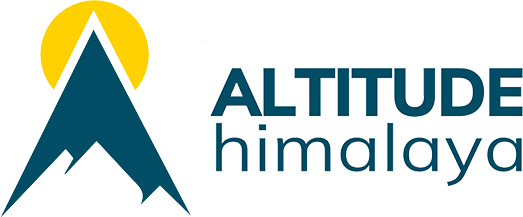



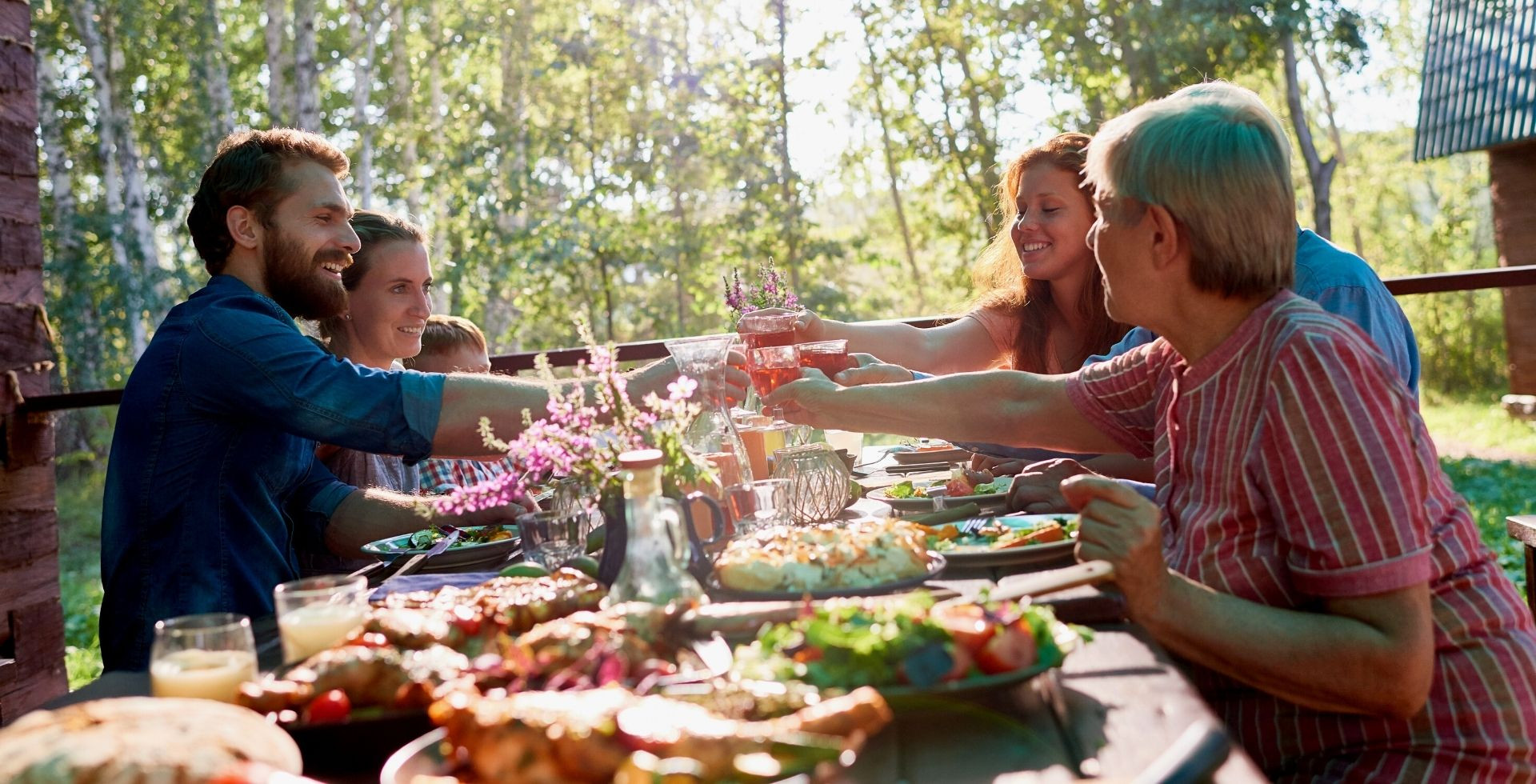
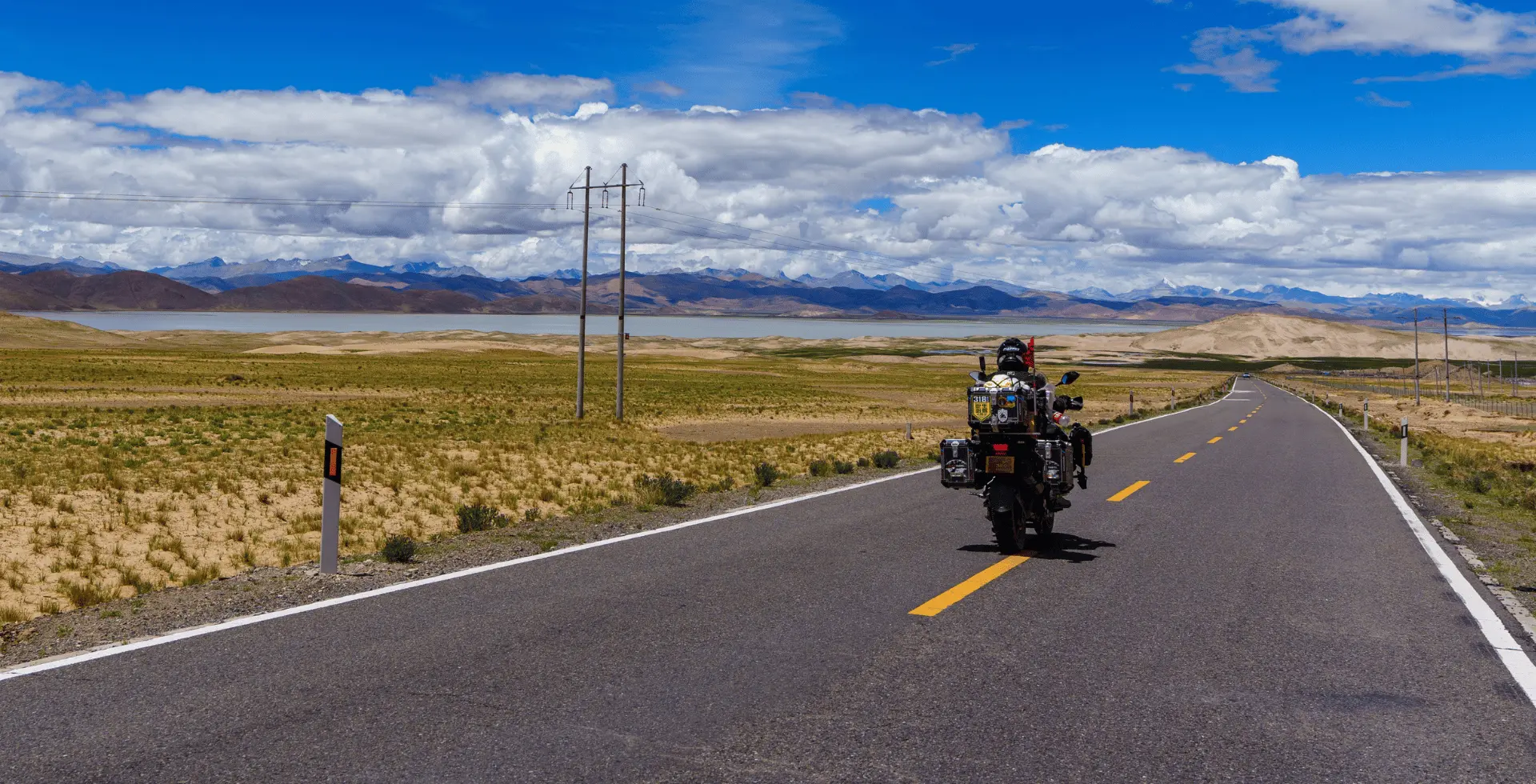
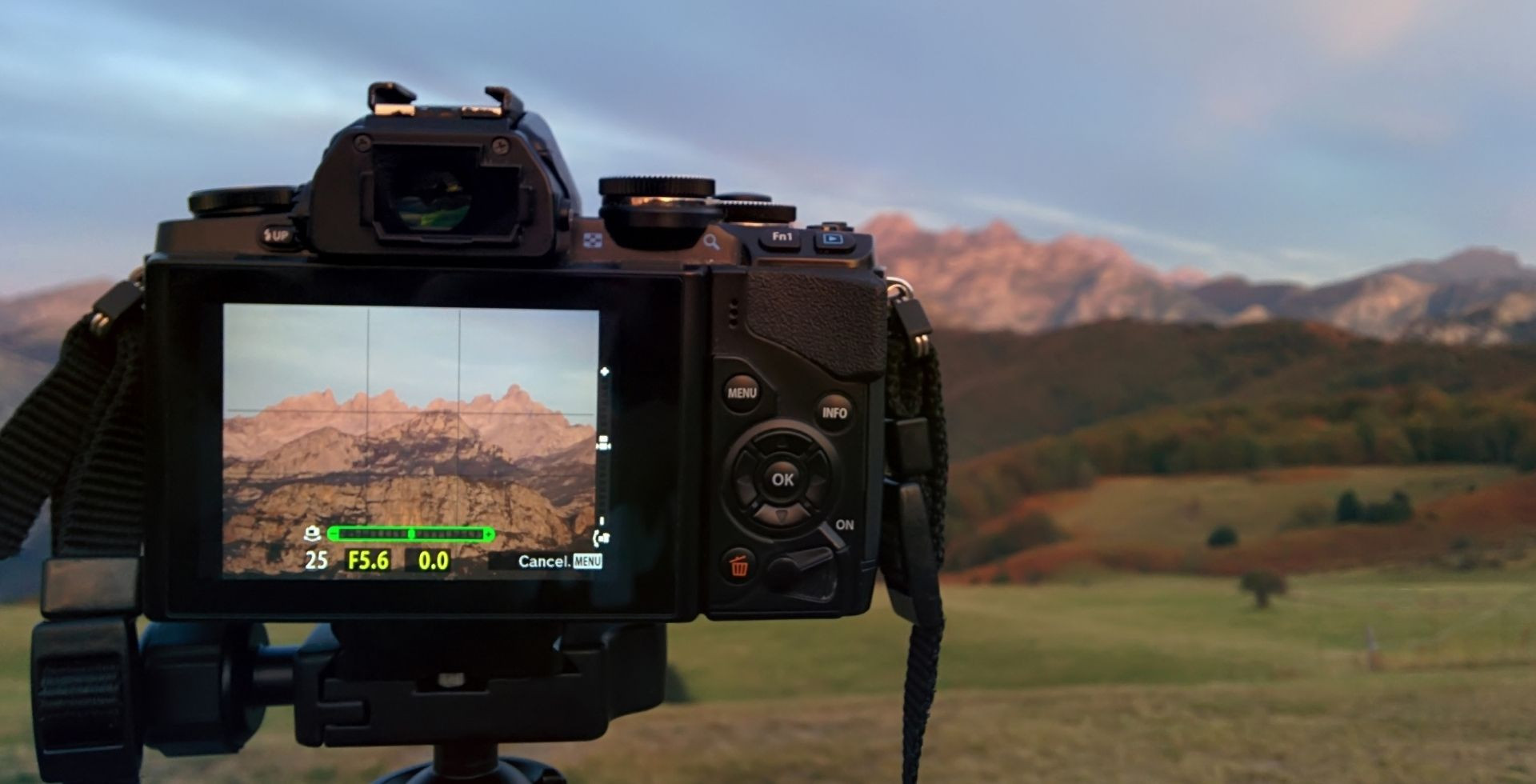
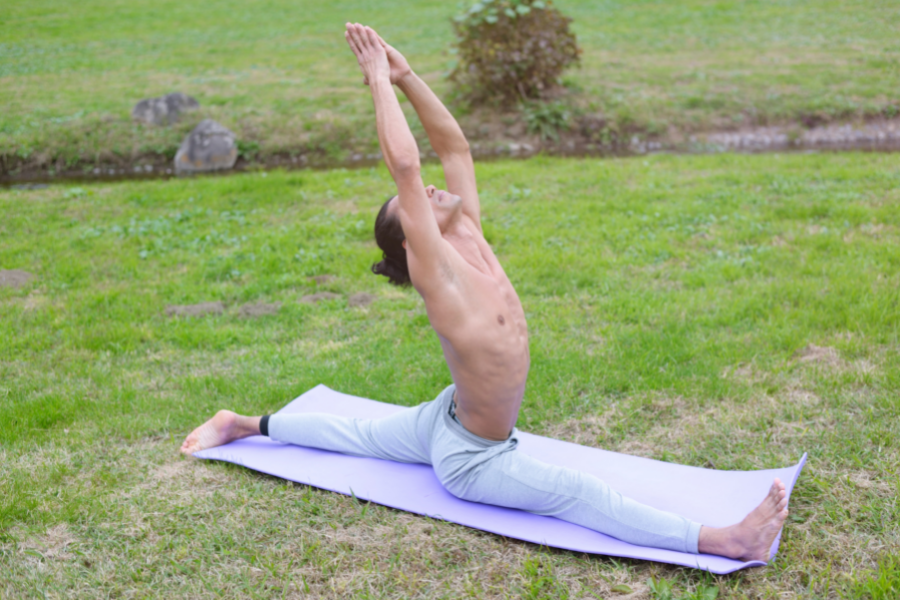
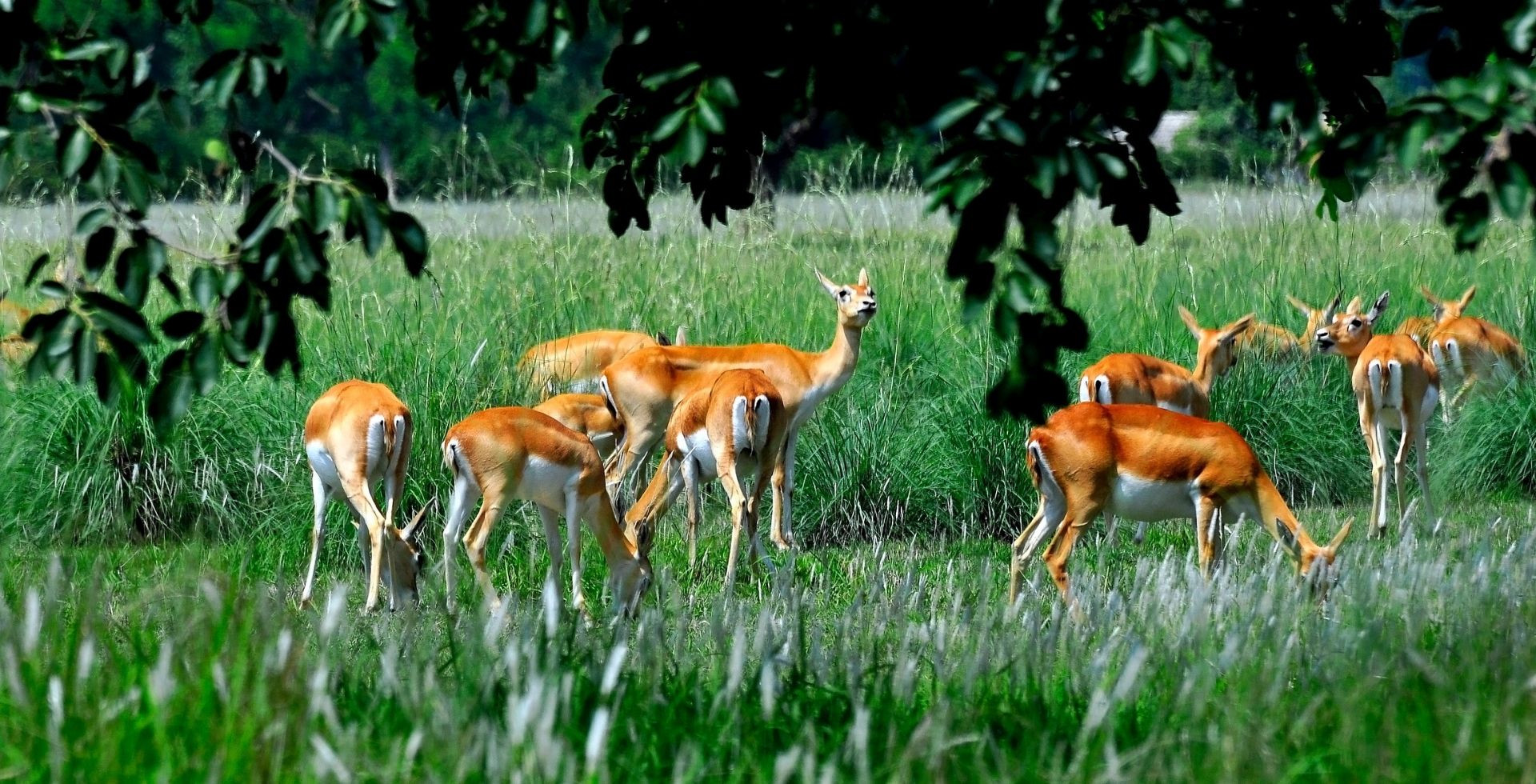
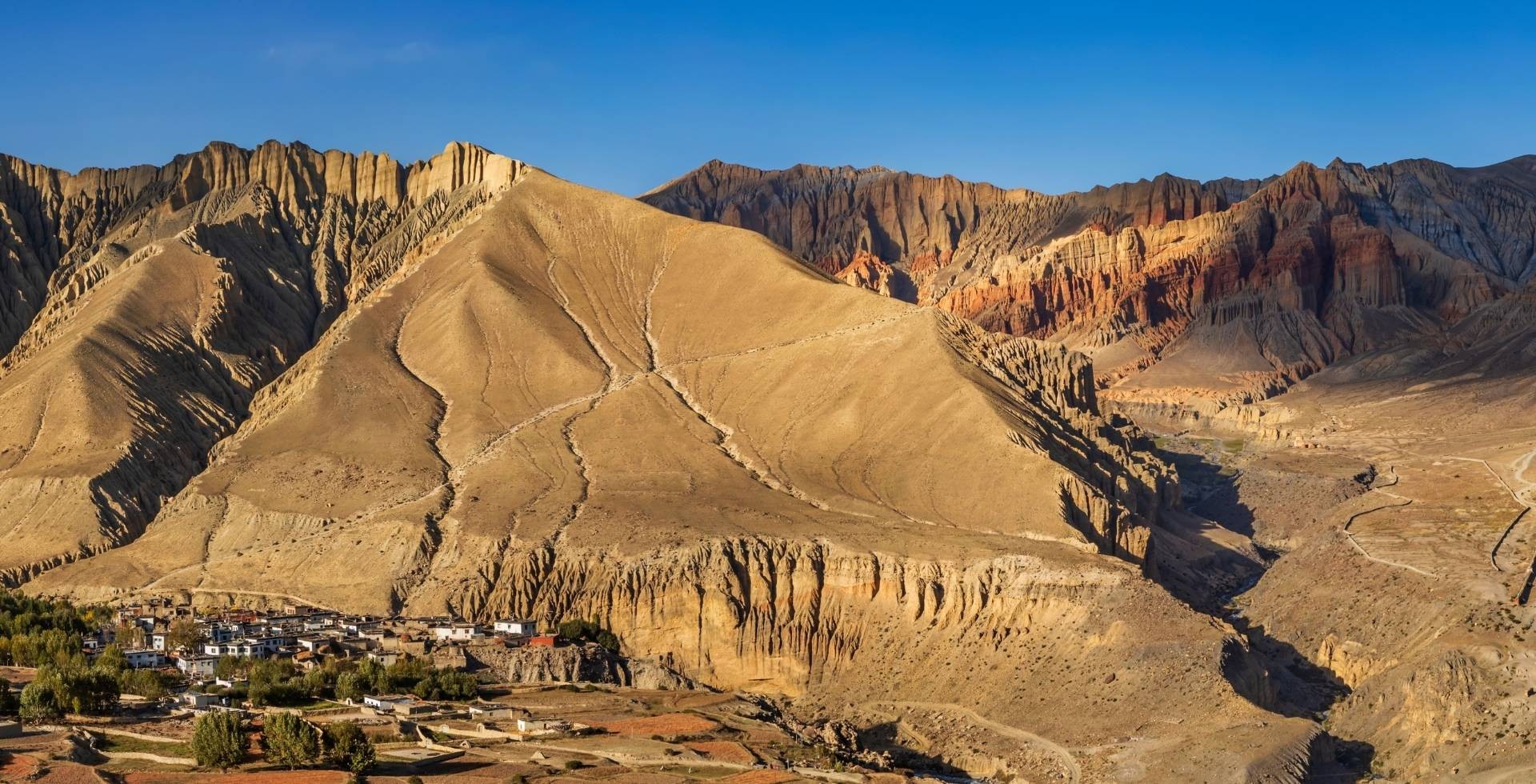

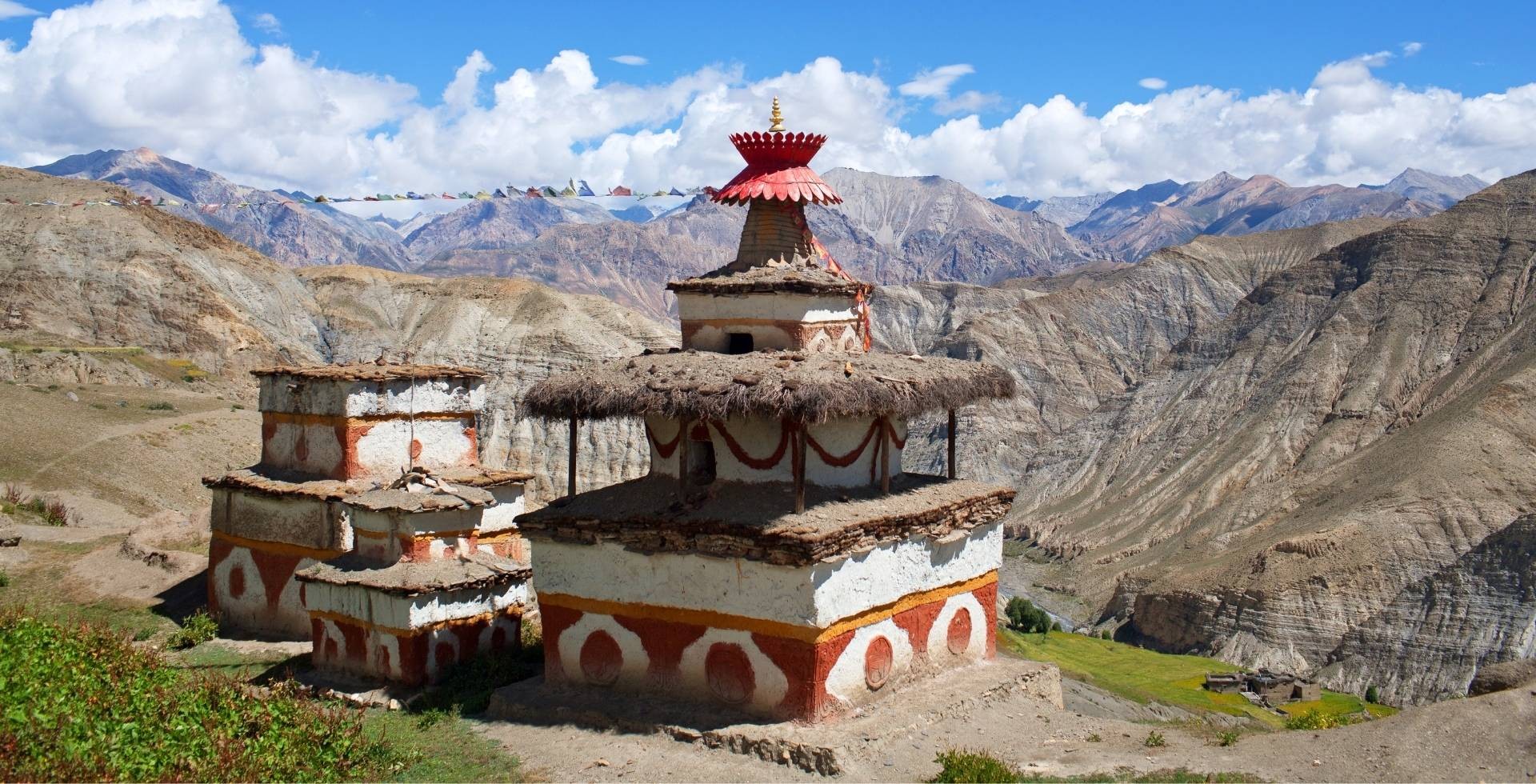
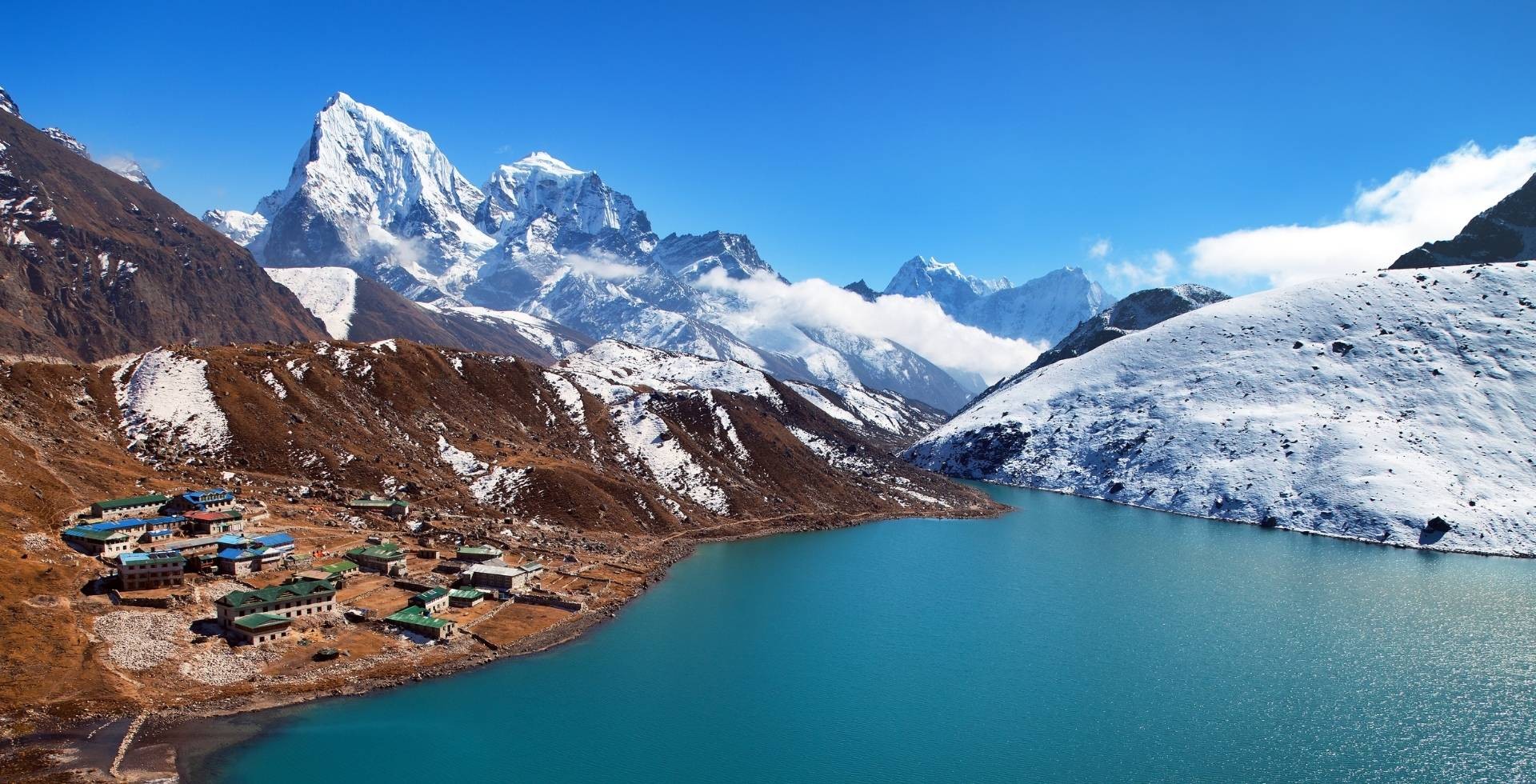

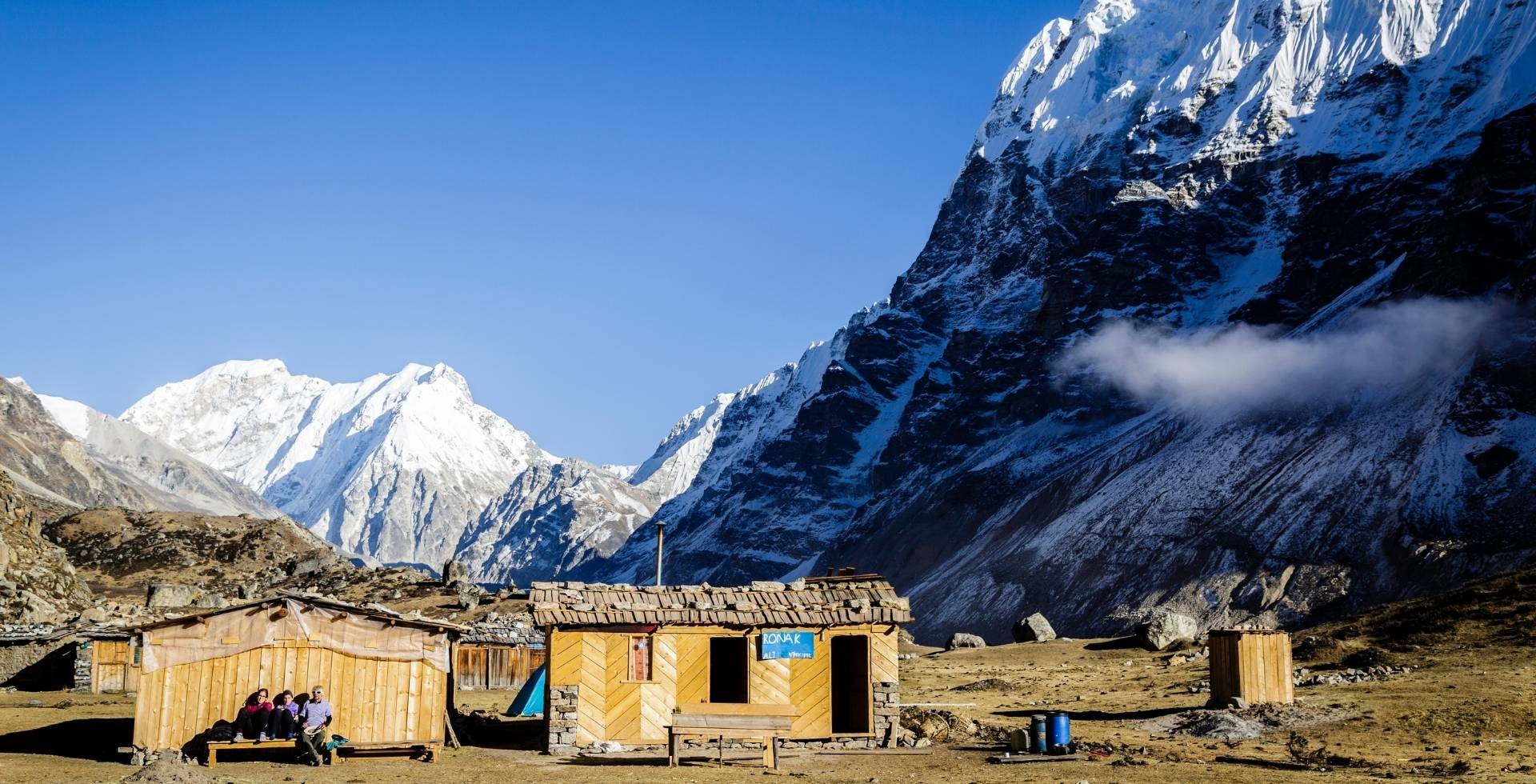
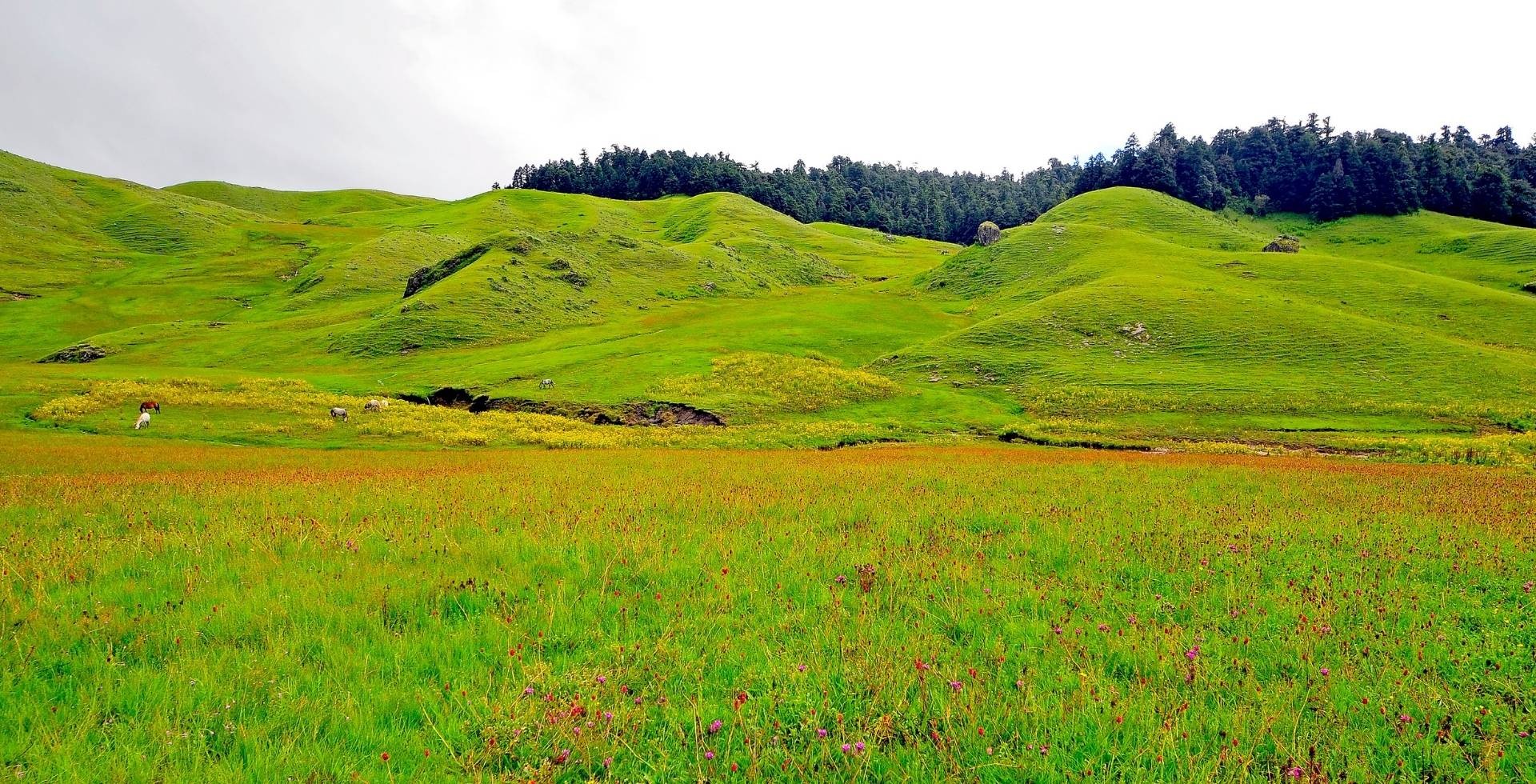
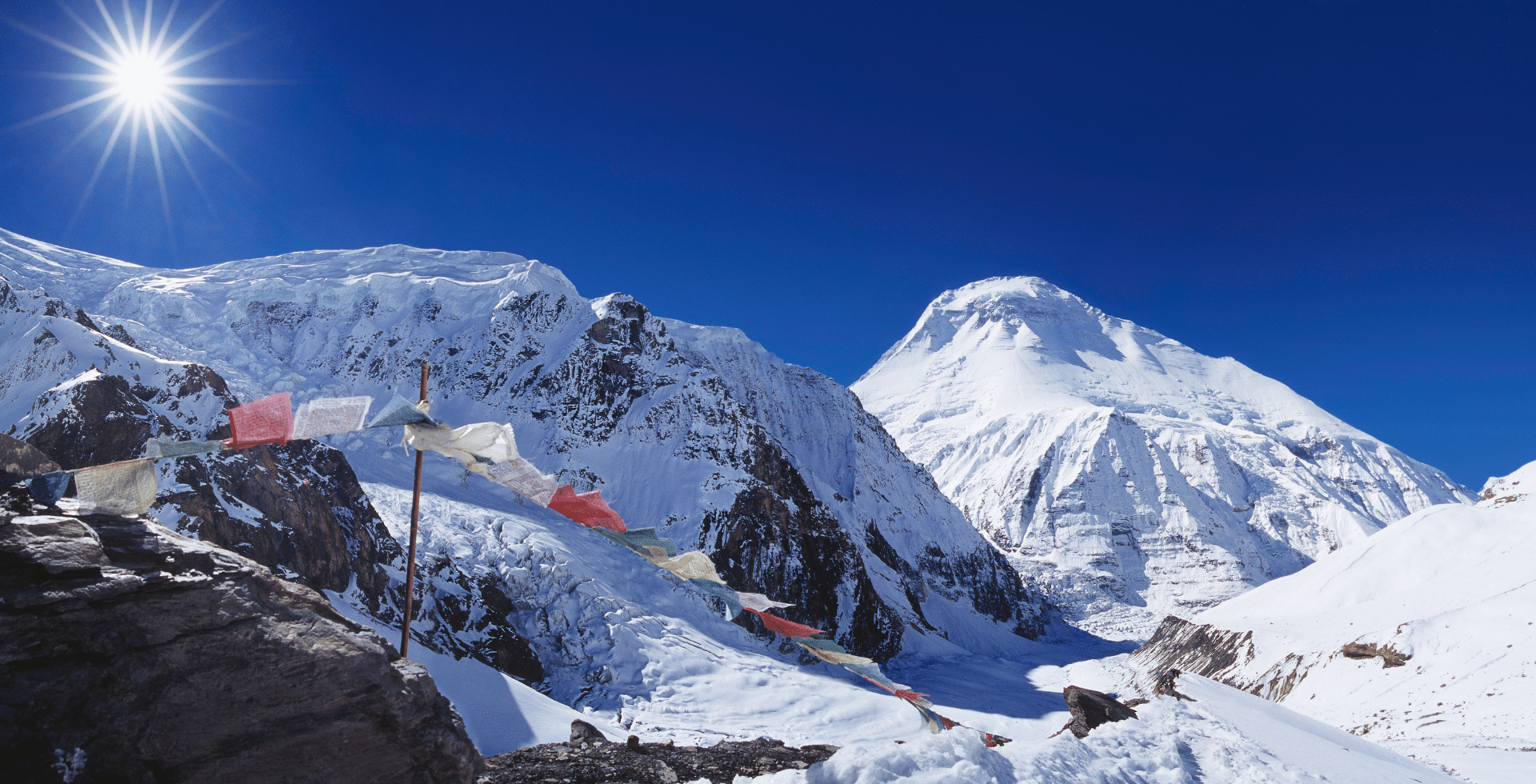
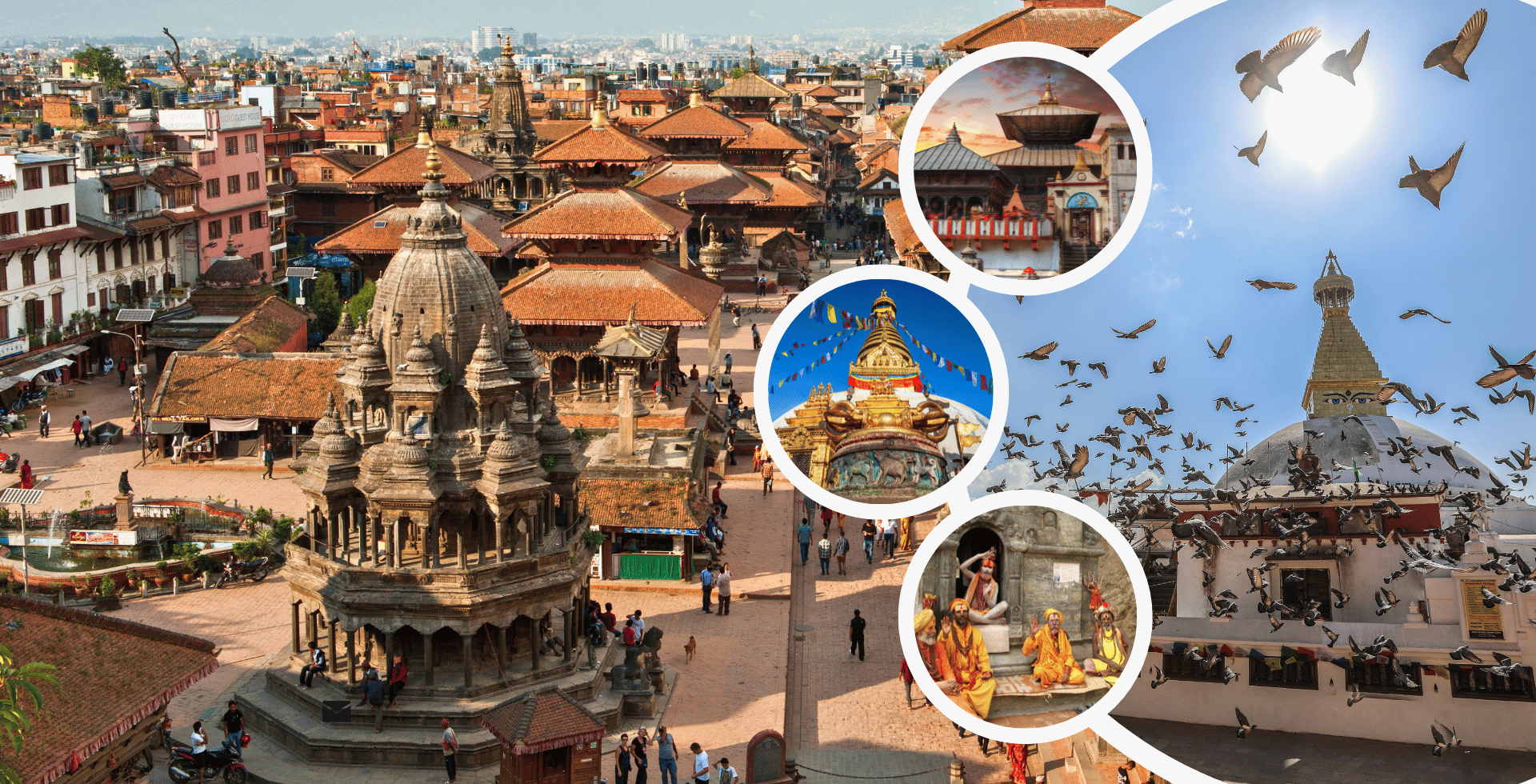
 Kiran Neupane
Kiran Neupane